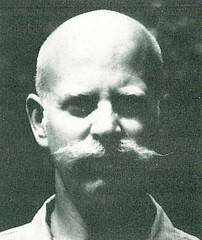 Today's passing of W. Philip Cotton, Jr. marks the end of an era. Phil -- born in Columbia, Missouri as William Philip Cotton, Jr. -- was one of St. Louis' early preservation pioneers. An architect by training, Phil became a tireless advocate for historic architecture out of the necessity of his times. After graduating from Princeton in 1954, Phil moved back to St. Louis in time for the urban renewal years.
Today's passing of W. Philip Cotton, Jr. marks the end of an era. Phil -- born in Columbia, Missouri as William Philip Cotton, Jr. -- was one of St. Louis' early preservation pioneers. An architect by training, Phil became a tireless advocate for historic architecture out of the necessity of his times. After graduating from Princeton in 1954, Phil moved back to St. Louis in time for the urban renewal years.In 1966, Phil wrote the National Historic Landmark nomination for the Wainwright Building. He also was active in efforts to get Lafayette Square designated as a Historic District in the National register of Historic Places. The 1969 listing of the Square helped prevent plans for a highway that would have destroyed the eastern end of the neighborhood. In this time, Phil was also an outspoken advocate for the reform of city tax laws that rewarded owner inaction in maintenance and discouraged investment.
In 1969, Phil was part of a group of architects, historians and planners that created Heritage/St. Louis. Heritage/St. Louis is one of the early advocates' greatest gifts to future preservationists: a citywide architectural survey conducted by volunteers between 1969 and 1976. Although documentation was simply a photograph, address and short assessment of buildings, the survey allowed for thousands of buildings to be documented -- many for the last time. Heritage/St. Louis' inventory of images from north St. Louis grows valuable every day. Sponsored by the Landmarks Association of St. Louis (on whose board Phil once served) and the City Plan Commission, Heritage St. Louis' daily operations were oversaw by Executive Director Cotton.
The aim of the project, a 500-page book on the city's architecture to be published in the bicentennial year, was never realized. However, the survey sheets -- now in the archives of Landmarks Association -- are a civic treasure. Alongside this work, Phil also saw that architectural drawings for many major St. Louis buildings were microfilmed. One of Phil's greatest contributions to preservation was his understanding of the value of thorough documentation.
Alongside this work in the city, Phil also was active in the county (producing the survey 100 Historic Buildings in St. Louis County in 1970) and the state of Missouri. In the mid 1970s, Phil Cotton drafted the outline of the statewide preservation organization later to become Missouri Preservation. He remain a counselor to that organization until his death.
Phil also championed the city's official landmark program, and nominated the first 35 sites, structures and buildings to receive that designation. The city landmark program granted more than symbolic value or financial aid for preservation, but legal safeguards. Knowing Phil, I am not surprised that he sought the highest protection for the landmarks he valued the most.
Of course, throughout his service to the city and state as an advocate, Phil was an active preservation architect. Among his many restoration projects are the Piper Palm House in Tower Grove Park, the Mark Twain boyhood home in Hannibal, Missouri, the Collins House in Collinsville, Illinois, the Gittemeier House in Florissant, the Saline County Courthouse in Missouri and others. Not surprising, also, that Phil Cotton was an organist and aficionado of classical music whose knowledge was revered by his friends. Phil's interest in architecture seemed to stem from a larger concern about the legacy of culture we all share and must steward.
In recent years, Phil remained as persistent as ever -- even in the face of illness. He continued his service as a trustee of the Steedman Architectural Library of the St. Louis Public Library. He was named to the College of Fellows of the American Institute of Architects in 2002. When I first met Phil a few years ago, he was hard at work on editing a reprint of John Albury Bryan's Lafayette Square, published in 2007. Dogged and principled, opinionated and generous, articulate and fastidious, Phil Cotton left us a legacy to admire and emulate.
(A copy of Phil's 1978 essay "Architectural Space of St. Louis" is online here.)





3 comments:
I am Nelson Laffey, this year's commodore of the Valley Sailing Association, ValleySailing.org, where Phil sailed a 16 foot Comet and for many years won the Fleet championship and the Governor's Cup in the Comet fleet.
Phil spent much time teaching me to sail and discussing world finances. Up until this year, Phil continued to sail and continued to win.
Phil Cotton, in the early years, was one of the few to recognize the importance of 'neighborhood' preservation, as opposed to the narrower focus on preservation of the single house/site which then was the prevailing view held by groups like St. Louis's Landmarks Association, and its predecessor the Historic Sites Committee. Throughout the early 1970s, Phil's 'Heritage St. Louis' was the only ally of our tiny Soulard Restoration Group. Phil's architectural survey work, the publication of our Soulard neighborhood history, and the creation of a revolving fund for Soulard rehabs stand out as major contributions to the preservation of Soulard and other historic districts to follow.
What a great gentleman. He was like a diamond with many facets: architect of subtle creations, student of history, rider of Harley's, sailor of the Mississippi, speaker of german, student of French architecture, catalyst of historic preservation. I will miss his company but we will all miss his well-thought works.
Post a Comment